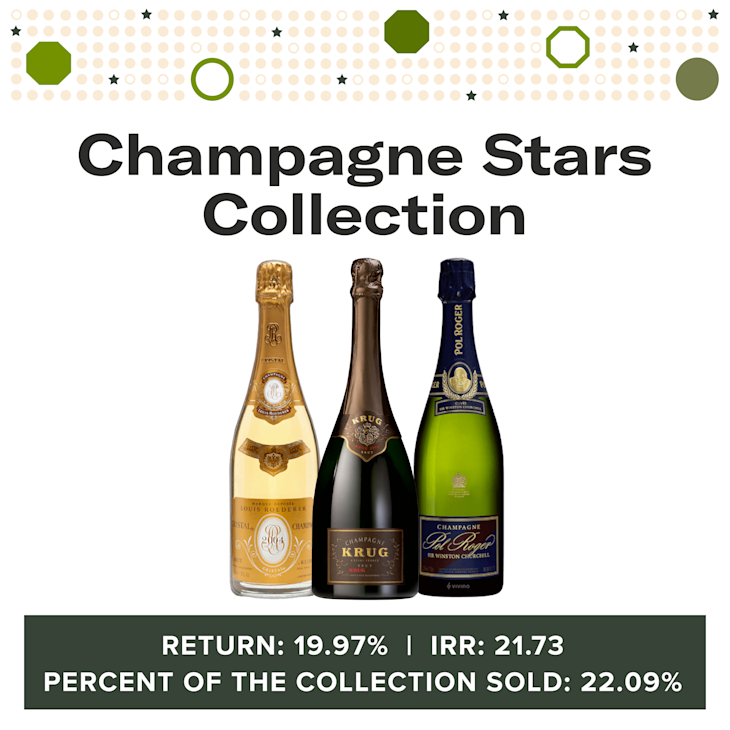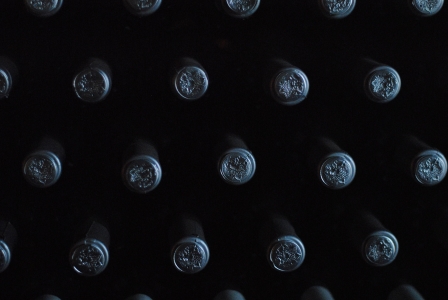Distributions on Vint Explained
As an investment company, our primary goal is simple: provide returns to our investors. That being said, we are very excited to announce our first distribution. This distribution will be paid out to all investors in our fourth collection, The Champagne Stars Collection, and represents a 19.97% return.
A Distribution from Vint represents the sale of a portion, or the entirety, of an offering (collection). Distributions represent the return of your cost-basis, proportioned to the percent of an offering sold, plus any returns on that sale.
Let’s run through a sample breakdown of a distribution.
Our Example Collection has a few key stats to it.
- 100 bottles
- $100,000 Collection Offering Value
- $100/share
- 1,000 shares
Each bottle has an Implicit Value relative to the Collection Offering Value. To keep it simple, let’s make each bottle is worth 1% of the Collection Offering Value.
Vint identifies an exit opportunity for 10 of the bottles in the collection for $11,000 net any applicable taxes. This amount represents the total distribution to be dispersed back to investors.
Vint has $11,000 to distribute evenly across the 1,000 shares in the collection, or pro-rata. For every share that an investor owns in the Example Collection, they will receive $11 at the end of the quarter.
The Champagne Stars Collection Distribution
As a region with a strong reputation and consistent historical performance, Champagne was selected to be included as one of the first five Vint collections.
The market indicators supported this decision as Champagne performed well in 2020 and early 2021 despite the disruptions caused by the pandemic, and seemed poised for a breakout. At sourcing, we were able to acquire excellent vintages from top producers for competitive acquisition costs, allowing us to offer the collection to our community at a favorable entry price.
The wine and spirits team utilizes a wide range of inputs to monitor the ongoing performance of individual collections. Our process is largely quantitative, incorporating data on trading volume, stock availability, and global pricing trends into our models.
We also focus on compiling qualitative data that may be catalysts for price appreciation, such as critical acclaim for individual wines, growing ‘buzz’ about a region or individual producer, and projections about the quality or size of future vintages. This holistic approach gives us a privileged view of favorable exit timing.
In the case of the recent champagne collection exit, we identified a ‘step change’ in market pricing for a number of the wines, and based on all of the available data, decided that it was an optimal moment to sell these assets and return profits to our investors.
Our Q2 Distribution represented the sale of approximately 22% of the VV-CHAM collection, for a return of 19.97%, or 21.73% IRR (Internal Rate of Return: an annualized return figure).
We're Very Excited by This Number For a Few Reasons.
First, this provides evidence for what we've been telling investors over the last 13 months: Wine and spirits have a relatively low correlation factor to traditional markets and thus offer the opportunity to diversify one's portfolio to hedge against market downturns.
Second, as we write this in late June of 2022, market sentiment is anything but positive. We are in our second week of an official bear market among traditional equity markets. The major indices are down anywhere between 10-25% YTD and finding returns outside of day-trading is becoming increasingly difficult.
Lastly, our distribution provides investors with an opportunity to re-invest in upcoming collections. With inflation rising and markets falling, sitting on cash can be a costly mistake, while investing in traditional markets feels riskier than ever.
Future Distributions
The unique nature of our offerings, with some collections having hundreds of bottles, means the sales process of those assets isn’t always going to be restricted to a single buyer. Breaking up collections instead of seeking a single buyer allows us to be more aggressive with our pricing, sell or hold individual labels/vintages based on market performance, and maximize returns for our investors.
One thing investors can agree on is diversification. Our collections are structured in a way that allows for our investors, whether they have invested $100 or $100K, to participate and add a share of many different collections to their portfolio. This means that in the future it is quite possible that an investor will be receiving distributions from multiple collections with these quarterly disbursements.
Disclaimer: Vint does not guarantee the partial or complete sale of any collection. Please view the full disclaimer located in the footer of our website.


